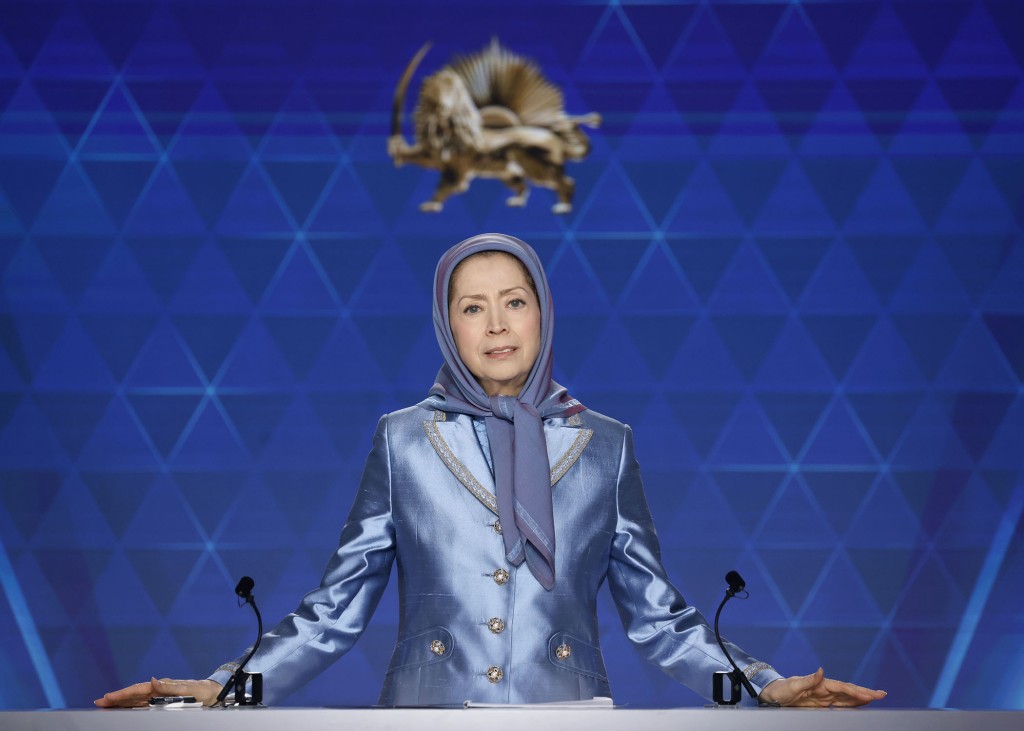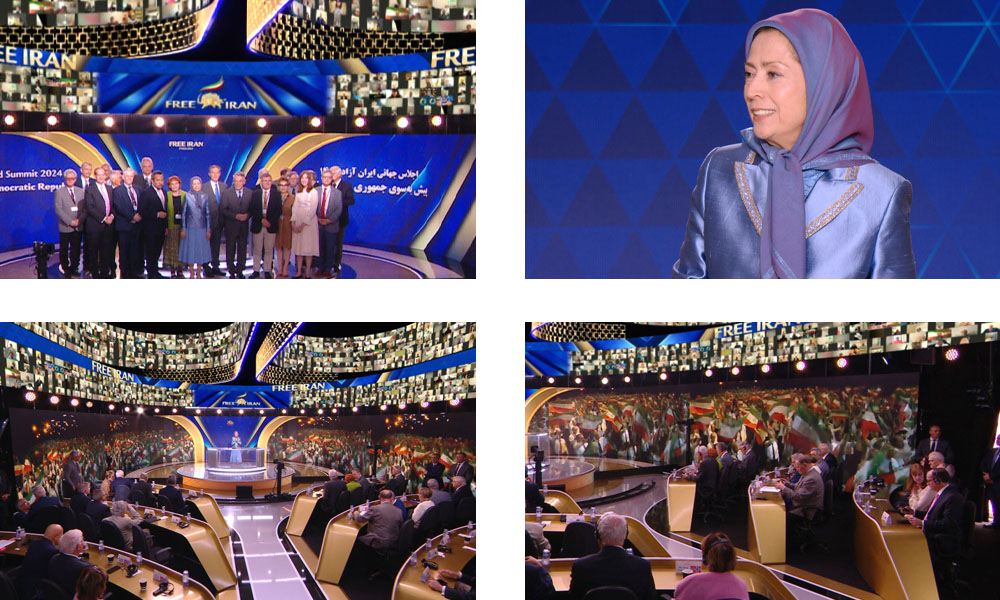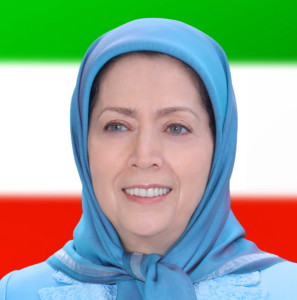Speech of Maryam Rajavi at the Free Iran 2024 Summit

Fellow compatriots, PMOI freedom fighters at Ashraf-3,
Honorable Legislators, Jurists, Lawyers,
Respected Human Rights Experts, and Dear Friends,
On this third day of the Free Iran World Summit, we extend our warmest greetings to those who have fought and sacrificed their lives to uphold human rights in Iran.
We honor those who fight and sacrifice their lives, as they face a grim reality under the rule of oppression and injustice, enduring torture, solitary confinement, and the noose. They have forsaken their own rights to help the Iranian people win theirs. We also honor those who, like yourselves, rise to defend them and all the oppressed despite all the pressures, stigmatization, and threats. The brilliant words of the great human rights martyr Kazem Rajavi will never be forgotten. He said, “We write the history of human rights with our blood.”
Lack of International Accountability for Crimes Committed by the Mullahs
Iran holds a contemporary world record in many forms of repression, including the imprisonment and torture of at least 500,000 people for political reasons and the execution of more than 100,000 political prisoners. Iran also has one of the highest numbers of executions each year. Last year, three-quarters of the executions recorded globally took place in Iran.
The absence of any international accountability for these crimes has emboldened the mullahs to shed blood without hesitation throughout the past four decades. This includes the blood-drenched saga of the massacre of the people of Kurdistan, the executions of the 1980s, the 1988 massacre, the brutal crackdown on protesters in 2009, 2017-2018, 2019, and 2022, as well as a series of terrorist operations and hostage-taking of foreign nationals.
The violation of human rights in Iran under the rule of the mullahs has never been limited to isolated decisions, rulings, or laws of the regime. Its essence lies in the systematic repression of the entire society, perpetuated consistently by the regime in its entirety, from its inception until today.
The Clerical Regime’s Tools for Suppressing Society
Suppression and control are pervasive processes deeply entrenched in every facet of society—from schools, universities, and workplaces to administrative units, the Internet, and both urban and rural environments. According to official reports, half a million people are arrested every year, though the actual figure is believed to be at least twice more. In universities, several bodies such as Basij, disciplinary committees, Herasat, and representatives of the Vali-e Faqih closely monitor students, often resulting in suspensions, expulsions, or arrests.
In factories, workers are closely monitored from all angles. The notorious Ministry of Intelligence with its Department of Security (Herasat), the Revolutionary Guard Corps (IRGC) with its Basij paramilitary forces, the government with bodies like the “Islamic Labor Councils,” “selection nuclei,” and inspection offices, as well as the State Security Force with its special units, contribute to this pervasive environment of suppression.
Indeed, suppression has cast a wide shadow over places of work and business practices. The oppressed ethnic groups, particularly Baluch, Kurdish, and Arab communities, face even more severe oppression. Followers of other religions are imprisoned, and their places of worship are closed down. Meanwhile, impoverished individuals seeking refuge in slums around cities see their homes demolished one after another. The institutionalized suppression and brutal assault on women, along with the imposition of religious tyranny, epitomize the history and the real image of this regime. Twelve ministries and 20 security and political institutions are dedicated to suppressing women and enforcing the compulsory hijab.
The International Independent Fact-Finding Mission declared that the crackdown on the 2022 protests and the pervasive and institutionalized discrimination against women and girls, in many instances constitute crimes against humanity.
They aim to instill fear and deepen repression, countering the protests and resistance of Iranian women. But the mullahs have failed. Ultimately, the pioneering role of the PMOI and other courageous women fighters will bring down the Velayat-e Faqih regime. The Law of Criminal Punishments in this regime is a chilling testament to its disregard for human rights. Just listen to the titles of these punishments: stoning, crucifixion, throwing people off cliffs, amputation of limbs, and gouging out eyes. There are dozens of crimes punishable by death and dozens of others punishable by flogging. Similarly, laws governing the press, political parties, elections, cyberspace protection, so-called “chastity and hijab,” among others, serve as tools and instruments in the regime’s relentless suppression of a society yearning for freedom. These laws reflect the regime’s ongoing war against a determined people who seek to overthrow the criminal rule of the mullahs. And of course, the dawn of liberation is not far.
The Iranian regime boasts a staggering array of official institutions dedicated to repression. Beyond these, numerous governmental and non-governmental entities also contribute to the repression system. This includes state-run radio and television, mosques overseen by Basij or Khamenei’s purported charity organizations, and notably, the regime’s judiciary, which is completely steeped in suppression and murder.
Human Rights and Freedom, Fundamental Principles of the Iranian Resistance
For our people and us, human rights, freedom, and the right to choose are fundamental principles. Following Khomeini’s rise to power in 1979, the PMOI endured the deaths of dozens of their colleagues over 28 months and exercised restraint in response to the imprisonment of thousands of their supporters. This was done to sustain political and peaceful activities for as long as possible.
However, the tyrannical regime, which fears even the slightest hint of human rights or freedom, has devoured everything. Indeed, this ruling barbarism has decimated civil society and eradicated any possibility of meaningful activity by the people within this framework.
Opposition political parties or any forms of white- or blue-collar labor organizations are strictly prohibited. Institutions ranging from bar associations to the medical sector and sports clubs are all controlled by either the IRGC or the Intelligence Ministry. The formation of independent unions or organizations by teachers is considered a crime. Filmmaking is only permitted if affiliated with official institutions, and activities by environmental defenders are systematically suppressed.
The consequence is that workers, teachers, journalists, artists, doctors, students, and athletes alike find themselves imprisoned in Khamenei’s vast prison. This is why they have determined that the only solution is to overthrow this regime. And they will ultimately achieve this noble objective.
Those who label this legitimate and just demand as perpetration of “violence,” whether intentionally or not, first, ignore or underestimate the brutal repression imposed by the ruling regime. Secondly, they reject the Iranian people‘s desire to overthrow the regime.
During the 2022 uprising, IRGC guards assaulted teenage girls and blinded protesters using pellet guns. Nevertheless, the protesters courageously declared, “No fear! We have sacrificed our eyes for the cause of freedom.”
To the ruling mullahs: The hands you break, the eyes you blind, and the blood you shed will never be forgotten. These sufferings, sacrifices, and bitter, blood-drenched memories starting four decades ago will forever remain in the historical memory of Iran and its people. They serve as inspiration for uprisings and generations of rebellious youths who will ultimately overthrow your regime.
Systematic Massacre Across All Sectors
Honorable friends,
What words can adequately express the tragedy of the systematic stoning of human rights in Iran? It is tantamount to a pervasive massacre across all aspects of life.
It is the massacre of civil society, the environment, livelihoods, production, knowledge, ethics, culture, noble concepts, and, above all, freedom itself. As a result, the hearts, minds, and emotions of Iranians are constantly wounded and in pain.
A poignant illustration of this pain is the massacre of 30,000 political prisoners 1988 with 90% being from the PMOI whose names and the locations of their graves remain largely unknown.
During the regime’s sham presidential election, one of the candidates was involved in the 1988 massacre as an executioner and a member of the Death Commission in Tehran. He admitted the existence of 30 Death Commissions, each consisting of three to five members. This admission vividly highlights the scale of the massacre.
Five years ago, the Iranian Resistance revealed the names of 36 members of these Death Commissions for the first time in the book “Crimes Against Humanity.”
Contrary to claims by regime accomplices portraying the executions as a reaction to the Eternal Light Operation, Mostafa Pour-Mohammadi acknowledged that this massacre was “a project of the Islamic Republic.” He stated, “We asked (the prisoners) if Massoud Rajavi were in Tehran now and opened the prisons, would you fight on his side against us? And they answered, ‘Yes, I would.’” And so, they were executed based on this response.
Ten days ago, in a new report, the United Nations Special Rapporteur on Human Rights in Iran declared the 1988 massacre and the executions of political prisoners in the 1980s as crimes against humanity, war crimes, and even genocide.
This report marks a necessary and commendable step that the United Nations failed to take during the ongoing massacre in 1988.
During that harrowing era, three weeks into the massacre in the prisons and as executions continued, Massoud Rajavi sent a telegram to the then Secretary-General of the United Nations on August 26, 1988. In this telegram, he revealed for the first time Khomeini’s handwritten fatwa or religious edict ordering the execution of PMOI political prisoners.
Now, 36 years later, the saga continues. The regime has initiated trials in absentia of Massoud Rajavi and more than 100 of his colleagues from the Iranian Resistance and the People’s Mojahedin Organization of Iran (PMOI). These trials have featured 14 sessions of grotesque spectacles, with witnesses from the regime’s torture and execution apparatus, including the daughter of Assadollah Lajevardi, known as the Butcher of Evin. All these witnesses advocate for the execution and mutilation of PMOI members.
The Iranian Resistance’s Determination to Build a Different Society
The atrocities committed by the clerical regime and the suffering of our people are immeasurable. However, today’s Iran is not defined by these oppressions, but by the fiery resistance and courageous protests of its people.
The regime’s extreme hostility towards humanity is a reaction to the powerful rebellious force that has emerged repeatedly in recent years through nationwide uprisings. The flames of the spirit of this resistance burn fiercely within the prisons of the clerical regime.
Political and PMOI prisoners have conveyed a message to this gathering from behind bars in the regime’s prisons, asserting: “We are the successors of the 30,000 unrepentant red roses massacred in the summer of 1988. We pledge never to surrender. Never!”
They declared, “There is no way to confront this regime except through struggle and resistance. We must fight for freedom and be willing to pay the price.” Hail to all political prisoners across Iran.
Indeed, while the mullahs consistently strive to sow fear in society, the greatest fear resides within their own ranks. According to an assessment conducted by the National Council of Resistance of Iran (NCRI)1 , the Iranian people have staged more than 6,300 protests annually since the 2017-2018 uprising.
The significance of this fervent resistance is clear: if the mullahs were to cease their suppression for even a day, their regime would be overthrown. In the end, the organized uprisings, resistance movement, and the Great Army of Iran’s Liberation will ultimately, and certainly, triumph over the mullahs’ brutal repression and ruthless tyranny.
This will of resistance is coupled with a steadfast commitment to construct a new society. Despite being the main party to endure executions and torture for four decades, the Iranian Resistance has championed the abolition of the death penalty. It will liberate Iran from the shackles of the regimes that tortures and executes people. Its goal is to transform Iran into a republic founded on freedom, democracy, equality, and human rights.
Let me emphasize the following, on behalf of the Iranian people and the Iranian Resistance, to the United Nations and its member states:
- End the impunity of Iran’s rulers. Khamenei, the head of the Judiciary and IRGC commanders are among the worst perpetrators of crimes against humanity and genocide in contemporary history. Bring them to justice in an international court.
- Expel the agents and mercenaries of this regime from your countries.
- Recognize the legitimacy of the just resistance of the Iranian people for freedom, and the struggle of rebellious youths and Resistance Units to overthrow this regime.
- Stop appeasing the mullahs’ regime. Stop sacrificing human rights and the Iranian Resistance. Do not provide more opportunities to the tyrannical regime for repression and warmongering. Make the continuation of relations with this regime contingent on the cessation of executions and torture in Iran.
The Iranian people and their vanguards will overthrow the religious dictatorship and they will achieve freedom and democracy. This day is not far!
Thank you all.

Speech of Maryam Rajavi at the Free Iran 2024 World Summit Onward to a Free Iran
https://www.maryam-rajavi.com/en/free-iran-world-summit-2024-onward-to-a-free-iran/
Speech of Maryam Rajavi at the Free Iran 2024 World Summit – Day 2
https://www.maryam-rajavi.com/en/free-iran-2024-roadmap-of-iranian-resistance-for-a-democratic-republic/

